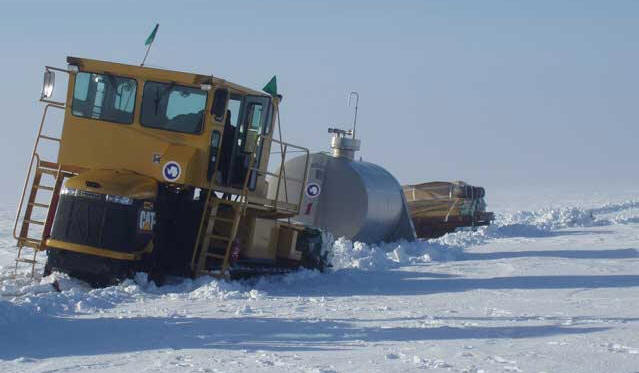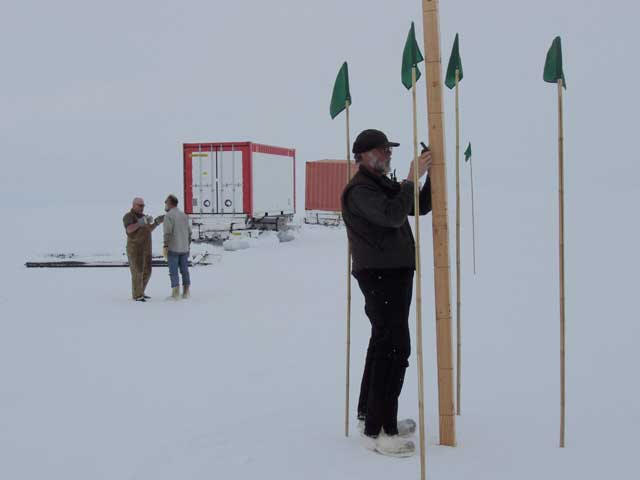
Snow slows traverse
By Kristan Hutchison
Sun staff
On a wide, white prairie, a caravan of tractors and trailers halted and five men stepped out, holding wrenches and arc welders the way John Wayne and Clint Eastwood once slung guns.
"It's like a spaghetti western in an Antarctic setting," said Scott "Scooter" Metcalfe, a mountaineer who spent the last month with the South Pole traverse crew he dubbed "The Problemsolvers."
Sleds wallowing in powdery snow, pins snapping and chains breaking - nothing stopped John Wright, Russell Magsig, John Penney, Rich "Stretch" Vaitonis and James McCabe as they forged a path southward. But the numerous challenges caused by unexpected snow conditions did slow the traverse, which at times slogged along at a walking pace.
"Though we are disappointed that we are not making the southward advance at a better pace," Wright wrote in a report Dec. 10, "each man among us is committed to advancing south as far as half our fuel will take us before heading back to the barn, learning as much as we can about crossing this Ross Ice Shelf."
The traverse was the second in a three-year proof of concept program to test the possibility of partially supplying Amundsen-Scott South Pole Station by land. Last year the traverse crew crossed the Shear Zone, filling in crevasses in the heavily cracked area as they went. This year five vehicles left McMurdo on Nov. 18, pulling fuel, supplies, and living quarters, to see how far south they could get.

The caravan turned around Dec. 30, short of half-way to the South Pole. In 43 days they had gone 690 km south, 480 km farther than last year. Despite the difficulties, they accomplished their primary goal to test the traverse concept while traveling as far south as possible. Now back at the Shear Zone, they return to McMurdo with clear understandings of which vehicles and other pieces of equipment did or didn't work, and also with an idea of the terrain they face.
"This is a place that no one else has ever been," Metcalfe said.
The basic concept of creating a trail that will be easier to travel has worked. They left a compacted trail 6 meters wide marked with green flags every half kilometer. Along the way they checked that the route was crevasse free for 6 meters on either side.
While the journey south was slow going, sometimes only about 15 km a day, the return has been much faster. On the first day north the vehicles went 75 km, almost twice the distance they could have done breaking trail to the south. It helped that they were pulling lighter loads and did not have to shuttle cargo, Wright wrote.
"The ultimate cause for our improved performance, however, is the crudely groomed snow surface we built behind us as we broke trail heading south," Wright wrote. "We had no expectation that our efforts would work as well as it appears to be doing now, given the horrid snow conditions we faced southward . but we are delighted."
Snow swamp
The southward journey was bogged down by a 300 km section of deep powder snow they referred to as the snow swamp. Though Antarctica is frozen, it rarely snows, so running into snow two meters deep and the consistency of sugar surprised the traverse team.
"We sink into this stuff and stir it up as soon as we're on it - right up to the belly pans," Wright wrote.
For the short time they were with the traverse, Metcalfe and Bert Yankielun from the Cold Regions Research and Engineering Lab dug snow pits every day at 6 p.m. They found 10 layers of snow in the pits, getting colder and more granular as they descended through the layers. "That could be 10 years of snow," Metcalfe said.
The granular snow wouldn't pack and provided little traction for the vehicles. Almost daily a sled or tractor would become stuck and need to be pulled out by the other tractors. Unseasonably high temperatures, sometimes up to 4C, worsened the snow.
"The warmer weather makes for soft snow surfaces," Wright wrote. "We sink pretty deep into this snow."
Instead of gliding on top of the snow, the sleds ended up plowing through it, pushing mounds of the snow in front of them. Eventually the pins holding the skis to the sled snapped. The pins had to be replaced and chains were used to secure the skis. The chains also broke under the strain. Though the snow surface was flat, occasionally old sastrugi were hidden under the snow.
"There is very little visual clue that these bear traps are out here, but when we go over one, we fall into the fluff on the back side of them and frequently get stuck," Wright wrote.
The traverse fleet included three tractors: a Case QuadTrack, a Cat Challenger-95E with a Fassi crane, and a Kress Modified Challenger-95E. While the Case and Cat proved to be almost as stalwart as the men, the Kress was soon recognized as a "fuel burning encumbrance." It had a tendency to rear up, digging deeply with the rear wheels. The two trailers of fuel the Kress started out pulling had to be cached early in the journey. In the deep snow the Case tractor went from pulling five fuel tank sleds to barely pulling two. The Cat went from two sleds to one.
"We're not power limited here, we're traction limited," Wright wrote.
When problems arose, the crew found a way to solve them, sticking to their motto "all is well."
"We're talking about complete hitches breaking and they're arc welding it on the spot," Metcalfe said. "This is a dedicated group of well-oiled machines. None could do better. John Wright shows incredible leadership skills."
The traverse drove at night, running 12 or more hours in the constant sunlight seven days a week. The living quarters were set up with all the necessities of life and none of the luxuries. Up to eight men lived together in a space the size of a shipping container. They had daily showers and heated pre-made meals in the microwave. An Iridium phone allowed them to check e-mail. But there was no time for recreation. Though someone brought a kite, "we didn't fly it because we were too tired," Metcalfe said.
The traverse crew is working at the Shear Zone this week and expect to arrive back at McMurdo prior to Feb. 1. Then they'll re-examine plans for next year, which had been to make it all the way to the South Pole and back.
"They're going to do a lot of things differently," Metcalfe said.
